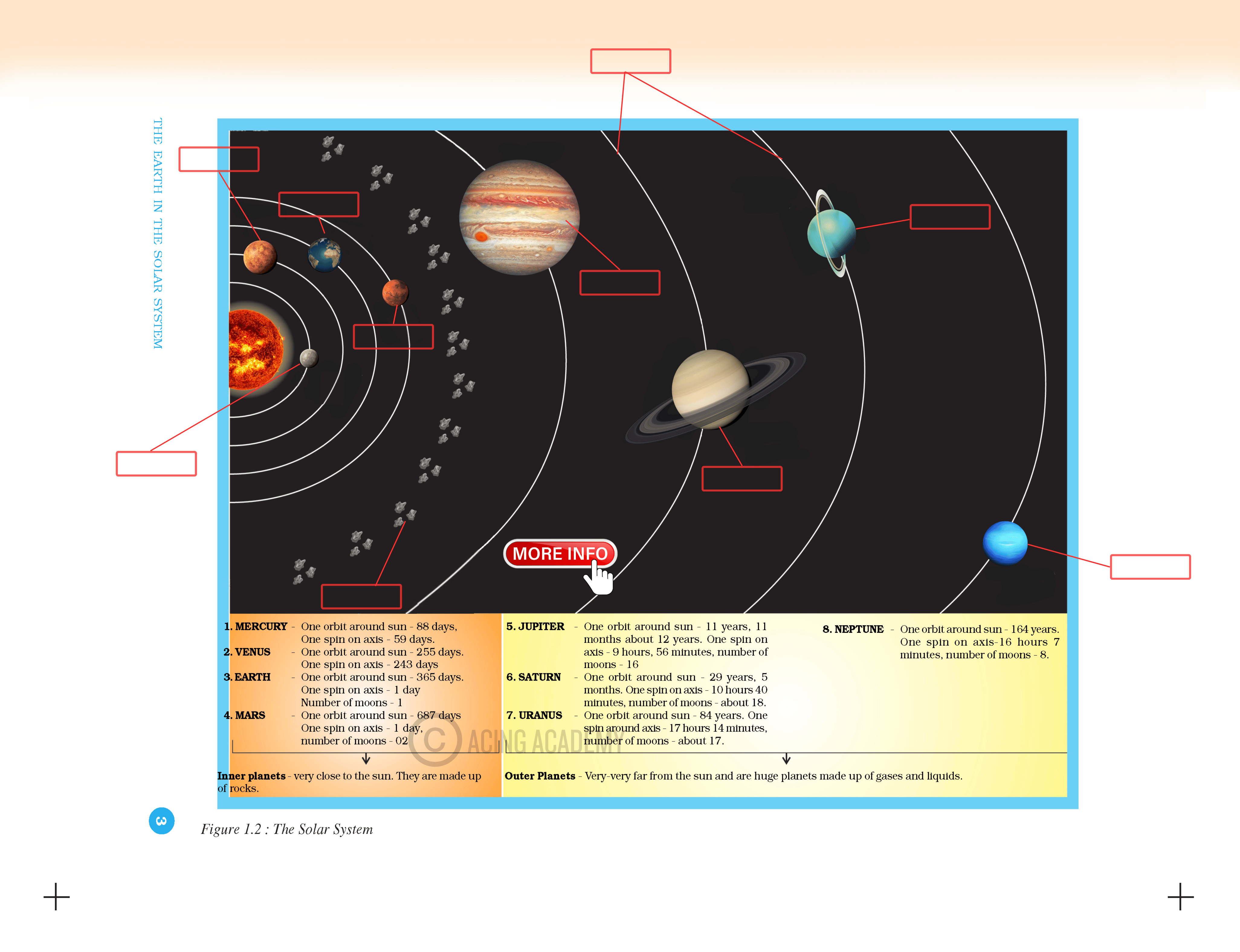
Venus
Venus is similar in structure and size to Earth, and
is sometimes called Earth's evil twin. Its thick atmosphere
traps heat in a runaway greenhouse effect, making it the
hottest planet in our solar system with surface
temperatures hot enough to melt lead. Its the 2nd Planet
from the Sun
Notable Features
⇒ Venus appears bright white from space because
of its thick clouds that reflect sunlight. However, if you
were standing on Venus, everything would look orange
because of the thick atmosphere that filters sunlight.
⇒ Venus is the second brightest natural object in the
night sky after the Moon. Venus is the first celestial
body to become visible in the sky at evening and is
the last one to disappear from the sky at sunrise.
Venus is called the Evening Star when it appears in
the western sky after sunset. It's called the Morning
Star when it appears in the eastern sky before sunrise
⇒ The surface of Venus is covered in volcanic plains,
valleys, mountains, and impact craters.
⇒ Venus's atmosphere is 96% carbon dioxide and 3%
nitrogen. It has 90 times the atmospheric pressure of
Earth
⇒ Venus spins clockwise on its axis, which is opposite
to the direction most other planets rotate. This means
that on Venus, the sun would appear to rise in the west
and set in the east.
Mercury
Mercury, the smallest planet in our solar system, it looks
similar to Earth's moon, with a surface covered in
impact craters.
Notable Features:
⇒ Mercury's surface is mostly greyish-brown, with bright
streaks called "crater rays". These rays are formed when
asteroids or comets hit the surface, throwing crushed rock
that falls back to the surface.
⇒ Mercury has gigantic cliffs, or scarps, that climb
thousands of feet above the terrain. These features
are the result of the planet's crust shrinking after it cooled
⇒ Atmosphere: Mercury has almost no atmosphere
Earth
We already Know about our Planet don't We?
Mars
Mars, also known as the Red Planet, appears as a
bright red dot in the night sky. Its the Fourth Planet
from the Sun
Notable Features
⇒ Color: Mars appears red because of the iron oxide
(rust) in its soil, dust, and regolith.
⇒ The surface of Mars is rocky and covered in craters,
volcanoes, dry lake beds, and canyons.
⇒ Dust storms: Mars has some of the largest dust storms
in the solar system, which can cover the entire planet.
⇒ Atmosphere: Mars has a thin atmosphere that's mostly
carbon dioxide and contains very little oxygen.
Jupitar
Jupitar the biggest planet in our solar system but being
a gas giant lacks a surface . It is the fifth planet from the
Sun. Jupiter's thick clouds create the appearance of
stripes. The planet's fast rotation creates strong jet
streams that separate the clouds into dark belts and
bright zones.
Notable Features
Saturn
Saturn is a giant gas planet with a yellowish-brown color
and a ring system. Saturn is yellowish-brown due to its
atmosphere, which is made up of hydrogen, helium,
ammonia, phosphine, water vapor, and hydrocarbons
Notable Features
⇒ Rings: Saturn's rings are made of chunks of ice and
rock, and are made up of many tiny ringlets
⇒ Shadow: The shadow of Saturn on its rings adds to the
3D appearance of the planet
⇒ Spokes: The rings can have spokes that are made of
tiny ice particles that are lifted by an electrostatic charge
Uranus
Uranus looks blue-green with faint rings. Its blue-green
color comes from methane gas in its atmosphere. It's the
seventh planet from the Sun and the third largest planet
in our solar system.
Notable Features
⇒ Rings: Uranus has 13 known rings, with the inner
rings being narrow and dark and the outer rings being
brightly colored and easier to see.
⇒ Atmosphere: Uranus's atmosphere is mostly hydrogen
and helium, but it also has methane. The atmosphere
looks quite calm, with very few clouds.
⇒ Rotation: Uranus rotates on its side, at a nearly
90-degree angle from the plane of its orbit. It also
rotates in the opposite direction as most other planets.
Neptune
Neptune is an ice giant planet that appears blue and has
a smooth surface because it's made of gas. Neptune
is the eighth and most distant major planet from the Sun
Notable Features
⇒ Rings: Neptune has six rings, but they're very hard
to see. A 2022 image taken by the Webb's Near-Infrared
Camera (NIRCam) brought the planet's rings into focus
for the first time in over 30 years.
⇒ Atmosphere: Neptune's atmosphere is made of
hydrogen, helium, and methane.
⇒ Other features: Neptune has the Great Dark Spot,
Scooter, and the Small Dark Spot
Asteroid Belt
The asteroid belt is a torus-shaped region in our solar
system that contains millions of asteroids orbiting the
sun between the orbits of Mars and Jupiter.
Comparision of Inner Planets
| Parameters | Definition as a Whole | Mercury | Venus | Earth | Mars |
| Surface Density (gm/cm3) | Inner or Terrestrial planets: Smaller and rockier. Have relatively high densities. | 5.4 | 5.2 | 5.5 (Highest) | 3.9 |
| Mass (Kg) | How massive a planet is has more to do with its composition and density.The four outer planets, called the gas giants, collectively make up 99% of the mass known to orbit the Sun. | 3.3×1023 kg | 4.8685 x 10^24 kg | 5.9736 x 10^24 kg | 6.4185 x 10^23 kg |
| Size (Radius) | A planet's size is not necessarily proportional to its mass. The size of a planet is determined by its composition and rotation speed. while Jupiter is 318 times as massive as Earth, its composition and density mean that it is only 11.21 times Earth's size. | 2,440 km | 6,052 | 6,371 | 3,390 km |
| Surface Gravity | Gravitational force a planet exerts upon an object at the planet's surface is proportional to its mass and to the inverse of the planet's radius squared. | 3.7 M/sec^2 | 8.9 M/sec ^2 | 9.81 m/s2 | 3.7 M/sec ^2 |
| Atmosphere | Generally inner planets have thin or very Little atmosphere with the exception of Venus | Thinnest | Thickest | Thicker to Mars | Thiiner to Earth |
| Temperature | Inner planets are hotter because of their closeness to the sun | +427 | +480(Highest) | +22 | -23 |
| Moons and Rings | Inner plaets have no or few moons.They do not have Rings | 0 | 0 | 1 | 2 |
| Brightness | Inner planets are Brighter | ||||
| Distance | Distance from Sun in (AU) | 0.4 | 0.7 | 1 | 1.5 |
| Type of Rotation and Period | Inner Planets Slower and Rotate Anti Clock Wise except Venus | 58 days | 243 days | 23:56 hrs | 1.025 days |
| Period of Revolution | Inner planets have Smaller orbits and move faster around the Sun | 87 days | 224 days | 365 days | 687 days (Highest) |
Comparision for Outer Planets
| Parameters | Definition as a Whole | Jupitar | Saturn | Uranus | Neptune |
| Surface Density (gm/cm3) | Outer planets: Larger and and are made up of gas. composed of low-boiling-point materials | 1.3 | 0.7 | 1.3 | 1.6 |
| Mass (Kg) | How massive a planet is has more to do with its composition and density.The four outer planets, called the gas giants, collectively make up 99% of the mass known to orbit the Sun. | 1.899 x 10^27 kg (Highest) | 5.685 x 10^26 kg | 8.682 x 10^25 kg | 1.024 x 10^26 kg |
| Size (Radius) | A planet's size is not necessarily proportional to its mass. The size of a planet is determined by its composition and rotation speed. while Jupiter is 318 times as massive as Earth, its composition and density mean that it is only 11.21 times Earth's size. | 69,911 km | 58,232 km | 25,362 km | 24,622 km |
| Surface Gravity | Gravitational force a planet exerts upon an object at the planet's surface is proportional to its mass and to the inverse of the planet's radius squared. | 24.9 M/sec^2 (Highest) | 10.4 M/sec ^2 | 8.8 m/s2 | 11.1 M/sec ^2 |
| Atmosphere | Generally outer planets have a very thick atmosphere | Thicker to Saturn | Thicker to Uranus | Thicker to Neptune | Less Thicker to Uranus |
| Temperature | Outer planets are colder because of they are further away from Sun | -150 | -180 | -214 | -220 |
| Moons and Rings | Outer Planets have Numerous moons . Their moons are, however, solid. They have extensive Ring Systems | 79 | 82 | 27 | 14 |
| Brightness | Outer planets are Less bright as sun’s light barely reach them | ||||
| Distance | Distance from Sun in (AU) | 5.2 | 9.6 | 19.2 | 30 |
| Type of Rotation and Period | Outer Planets Rotate Faster Anti Clock Wise except Uranus | 9.9 hrs (Fastest) | 10.7 hrs | 17 hrs | 16 hrs |
| Period of Revolution | Outer planets have Longer orbits and thus tae more time to move around the Sun | 11.9 years | 29 years | 84 years | 164 years |
Orbits
An orbit in the solar system is the curved/elliptical path
that an object takes around another object due to gravity.
The object in orbit is called a satellite, which can be
natural or human-made. Orbits in the solar system are
not visible
Here are some examples of orbits in our solar
system:
⇒ Earth's orbit: Earth orbits the sun, taking about one
year to complete a full orbit.
⇒ Moon's orbit: The moon orbits Earth, taking about one
month to complete a full orbit.


 UPSC Exams
UPSC Exams  UPSC CSE
UPSC CSE UPSC CAPF
UPSC CAPF UPSC CDS
UPSC CDS UPSC NDA
UPSC NDA UPSC EPFO
UPSC EPFO UPSC CISF LDCE
UPSC CISF LDCE State Upper PCS
State Upper PCS  UPPSC PCS
UPPSC PCS BPSC CCE
BPSC CCE RPSC RAS
RPSC RAS MPPSC (Madhya Pradesh) CCE
MPPSC (Madhya Pradesh) CCE MPSC (Maharasthra) Rajyaseva
MPSC (Maharasthra) Rajyaseva WBPSC WBCS
WBPSC WBCS GPSC CCE
GPSC CCE KPSC (Karnataka) KAS
KPSC (Karnataka) KAS APSC (Assam) CCE
APSC (Assam) CCE View More
View More Defence
Defence AFCAT
AFCAT BSF SI
BSF SI Indian Army Agniveer
Indian Army Agniveer Banking
Banking  IBPS PO
IBPS PO SBI PO
SBI PO RBI Grade B
RBI Grade B Cental Bank Of India Apprentice
Cental Bank Of India Apprentice IDBI Junior Assistant Manager
IDBI Junior Assistant Manager SSC
SSC  Police
Police  Bihar Police SI
Bihar Police SI UP Police SI
UP Police SI Delhi Police Head Constable
Delhi Police Head Constable Rajasthan Police SI
Rajasthan Police SI WB Police SI
WB Police SI Assam Police SI
Assam Police SI Odisha Police SI
Odisha Police SI Railway
Railway Other State Exams
Other State Exams Insurance
Insurance Regulatory Body
Regulatory Body